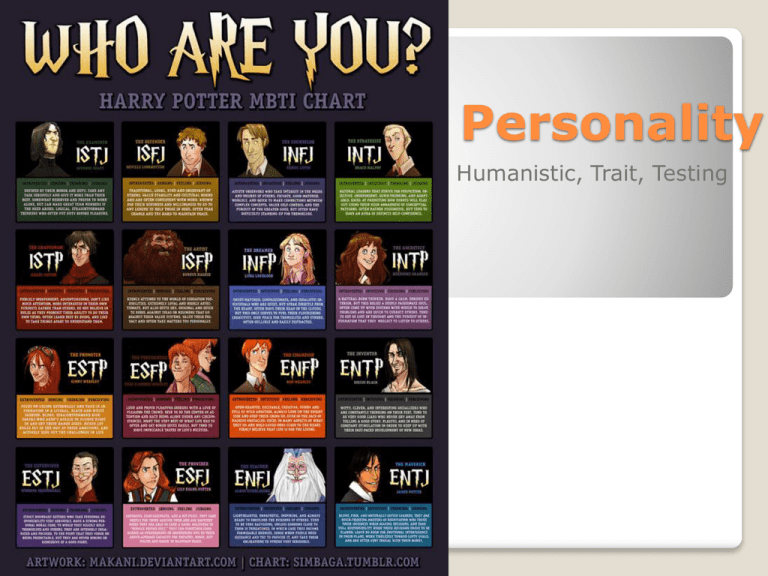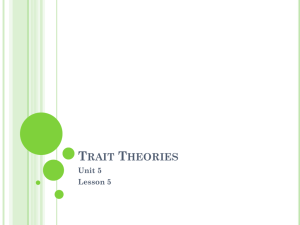Personality Theories
advertisement

Personality Humanistic, Trait, Testing Humanistic Perspective By the 1950s and 60s psychology moves away from Freud’s negativity and the mechanistic psychology of the behaviorists. Abraham Maslow (1908-1970) Carl Rogers (1902-1987) Self-Actualizing Person Abraham Maslow proposed that we as individuals are motivated by a hierarchy of needs. Beginning with physiological needs, we try to reach the state of selfactualization—fulfilling our potential. Self Actualized people are self aware, self accepting, open and spontaneous, creative, loving and caring, and not paralyzed by other’s opinions. “acquired enough courage to be unpopular, to be unashamed about being openly virtuous” College students most likely to become selfactualized were “privately affectionate to those of their elders who deserve it.” and “secretly uneasy about the cruelty, meanness and mob spirit so often found in young people.” Maslow estimated only 1% of the population reaches this level The top of the motivational hierarchy. This makes it the weakest of all needs and the most easily impeded. “This inner nature is not strong and overpowering and unmistakable like the instincts of animals. It is weak and delicate and subtle and easily overcome by habit, cultural pressure, and wrong attitudes toward it.” Jonah Complex – must be willing to sacrifice safety for personal growth. A fear of success. ◦ We Run away from responsibilities, freedom, Does society influence this? How does childhood influence this? Self Actualization Pablo Casals Albert Einstein Ralph Waldo Emerson William James Thomas Jefferson Eleanor Roosevelt Albert Schweitzer Examples of SA People Original work has been interpreted multiple times, stemming away from his original ideas. Some will state Maslow’s list of people is biased as he focused on what he thought represented the best of humans. ◦ Only those that had opportunity for success in that setting, European, and men Assessment of Maslow Carl Rogers Goal of every organism is to fulfill the capabilities of our genetic blueprint – actualizing tendency Human beings form images of themselves – called self concepts (genuine, innate desires) Drive to fulfill self-concepts – self actualizing tendency Struggled to understand the unhappiness of the people he encountered in therapy. The founder of personal growth and determination framework, which later leads to Positive and Motivational psychology. Believed that we all have a potential for a fulfilling life if we remove the obstacles that keep us from reaching it. Opposite of Freud’s world, which highlights our negative tendencies and compromises between impulses. Carl Rogers Did you write the same thing for each prompt? From a humanistic perspective, a fully functioning, self-actualized person finds the perceived self as completely congruent with the ideal self. Rogers suggests that if our self-concept is negative, that is, if we fall far short of our ideal self, we feel dissatisfied and unhappy. It follows that parents, teachers, and friends should help others know, accept, and be true to themselves Perceived Self vs. Ideal Self Assessing the Self In an effort to assess personality, Rogers asked people to describe themselves as they would like to be (ideal) and as they actually are (real). If the two descriptions were close the individual if a fully functioning person All of our thoughts and feelings about ourselves, in an answer to the question, “Who am I?” refers to Self-Concept. Humanistic view asserts the fundamental goodness of people and their constant striving toward higher levels of functioning Does not dwell on past occurrences, but rather focuses on the present and future Humanistic Personality Theories People who are central to our lives condition us to move away from our genuine feelings, to earn their love by pursuing those goals they value, even if those do not reflect our deepest wishes. Called Conditional positive reward (of worth) ◦ Acceptance and love contingent on certain behaviors and fulfilling certain conditions. Need to strive for unconditional positive reward ◦ Full acceptance and love of another regardless of our behavior Genuineness Accepting Empathy How to become fully functioning? Early Childhood Matters 1. Who is your most significant other at this time? 2. Do you have unconditional positive regard (UPR) for this person? Explain. 3. Does this person have UPR for you? Explain. 4. Are there conditions of worth in your relationship? If so, what are they? Answer in your unit guide. Evaluating the Humanistic Perspective 1. 2. 3. 4. Humanistic psychology has a pervasive impact on counseling, education, child-rearing, and management. Concepts in humanistic psychology are vague and subjective and lack scientific basis. Some view these theories as overly optimistic and that they ignore the nature of human evil Some argue that humanistic view lead to selfindulgence, narcissism and self-centeredness – Western view of hyper-individualism Trait perspective The Trait Perspective: Not Why but What An individual’s unique makeup of durable dispositions and consistent ways of behaving (traits) constitutes his or her personality. Examples of Traits Honest Dependable Moody Impulsive Founder of trait theory) Allport rejects the idea that the unconscious is central as well as dismissing the negativity of psychodynamic theory. ◦ “Are you that little boy.” Freud Goal was to define personality in terms of identifiable behavior patterns Description and classification Allport & Odbert (1936), identified 18,000 words representing traits. Cut this down to 200 – still too much Allport believed if you want to know something about someone, you just ask them. Gordon Allport Each person has a unique capacity to adapt to the environment Defined traits as mental structures that cause behavior to be similar across different situations ◦ Outgoing in the mall or in class Allport Continued Exploring Traits Factor analysis is a statistical approach used to describe and relate personality traits. Cattell used this approach to develop a 16 Personality Factor (16PF) inventory. Raymond Cattell (1905-1998) Factor Analysis Cattell found that large groups of traits could be reduced down to 16 core personality traits based on statistical correlations. Superficial traits Boisterous Impatient Irritable Excitement Basic trait Impulsive Personality Dimensions Hans and Sybil Eysenck suggested that personality could be reduced down to three polar dimensions, extraversion-introversion emotional stability-instability, and pychoticism The Big Five Factors Today’s trait researchers believe that Eysencks’ personality dimensions are too narrow and Cattell’s 16PF too large. So, a middle range (five factors) of traits does a better job of assessment. Openness/Culture Conscientiousness Extroversion/Introversion Agreeableness Neuroticism/ Emotional Stability Endpoints Questions about the Big Five 1. How stable are these traits? Quite stable in adulthood. However, they change over development. 2. How heritable are they? Fifty percent or so for each trait. 3. How about other cultures? These traits are common across cultures. 4. Can they predict other personal attributes? Yes. Conscientious people are morning type and extraverted are evening type. Evaluating the Trait Perspective The Person-Situation Controversy Walter Mischel (2004) points out that traits may be enduring, but the resulting behavior in various situations is different. Therefore, traits are not good predictors of behavior. * Level of aggression is different based on environmental context * She does A when X, but B when Y The Person-Situation Controversy Trait theorists argue that behaviors from a situation may be different, but average behavior remains the same. Therefore, traits matter.







